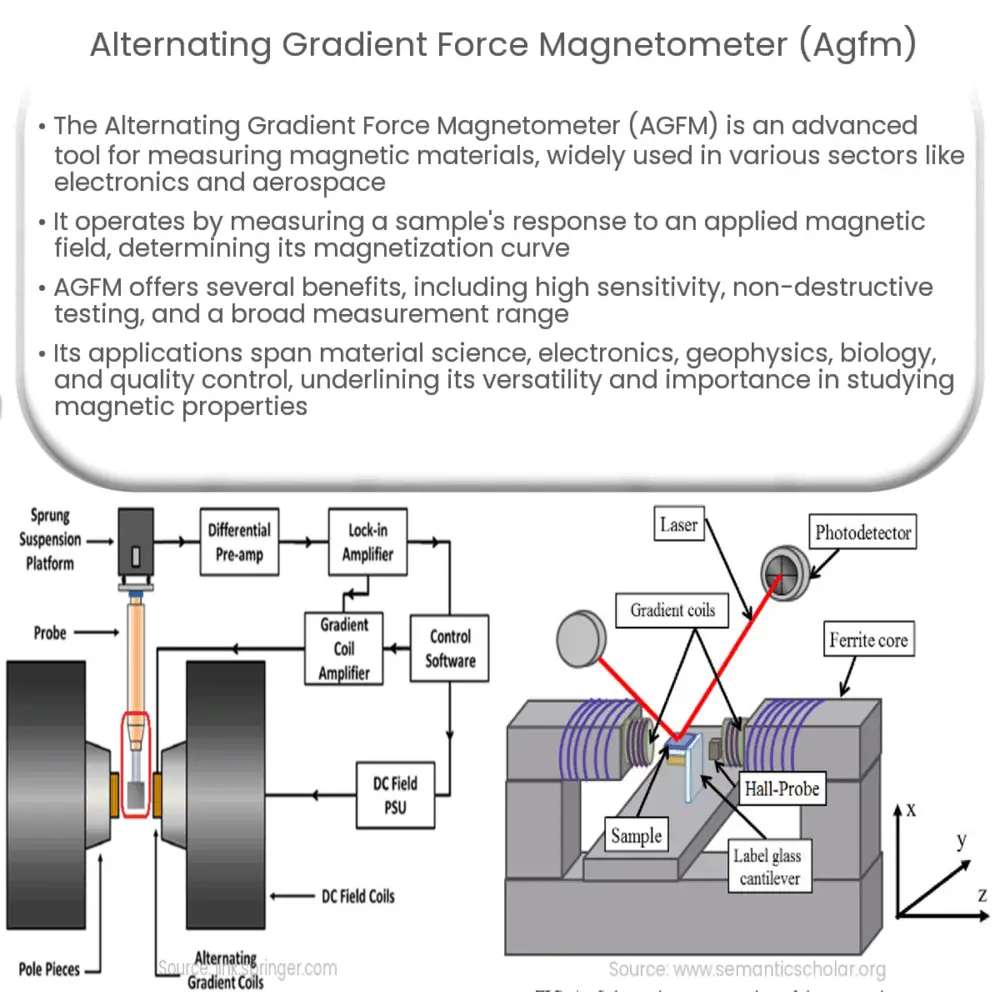The AGFM is a highly sensitive instrument used to measure and characterize magnetic materials, with applications in various research fields.

Alternating Gradient Force Magnetometer (AGFM): An Overview
Introduction
The Alternating Gradient Force Magnetometer (AGFM) is a highly sensitive and advanced instrument used for the measurement and characterization of magnetic materials. It is widely employed in research, development, and quality control applications in various industries such as electronics, aerospace, and materials science. This article provides a comprehensive overview of the AGFM, its working principle, advantages, and applications in different fields.
Working Principle
At the core of the AGFM is the principle of the alternating gradient magnetometer, which measures the response of a magnetic sample to an applied magnetic field. The sample is positioned between the poles of a pair of electromagnetic coils, producing a uniform magnetic field. An additional set of gradient coils creates an alternating gradient field, resulting in a force experienced by the magnetic moments of the sample.
The force exerted on the sample depends on its magnetic properties and the gradient of the magnetic field. As the gradient field oscillates, the magnetic moments of the sample attempt to align with the changing field, causing the sample to oscillate as well. The amplitude of this oscillation is proportional to the magnetic moment of the sample and can be detected by a highly sensitive displacement sensor, such as a capacitive or fiber-optic sensor.
By varying the strength of the applied magnetic field and measuring the resulting oscillation amplitude, the AGFM can determine the magnetization curve (also known as the hysteresis loop) of the sample. This information is vital for characterizing the magnetic properties of materials, such as coercivity, remanence, and saturation magnetization.
Advantages of AGFM
There are several advantages to using AGFM over other types of magnetometers, including:
- Sensitivity: AGFM is capable of detecting extremely small magnetic signals, making it suitable for measuring weakly magnetic materials and subtle changes in magnetization.
- Non-destructive: As the AGFM does not require direct contact with the sample, it provides non-destructive measurements, which is critical for delicate or valuable samples.
- Wide dynamic range: AGFM can measure samples with a broad range of magnetic properties, from diamagnetic to strongly ferromagnetic materials.
- High resolution: The high-resolution capabilities of AGFM allow for accurate measurements of magnetic properties and differentiation between materials with similar properties.
- Temperature control: Many AGFM systems include temperature control options, enabling the study of temperature-dependent magnetic properties and phase transitions in materials.
Applications of AGFM
Due to its versatile nature and high sensitivity, AGFM finds applications in various fields, including:
- Material Science: AGFM is widely used to study the magnetic properties of novel materials, such as thin films, nanoparticles, and multilayer structures. It helps researchers understand and optimize their magnetic behavior for specific applications.
- Electronics: In the electronics industry, AGFM is employed to analyze magnetic components, such as magnetic recording media, read/write heads, and magnetic sensors. It helps improve the performance and reliability of these devices.
- Geology and Geophysics: AGFM is used to investigate the magnetic properties of rocks and minerals, helping geologists understand Earth’s magnetic history and aiding in the exploration of natural resources, such as oil and minerals.
- Biology and Medicine: AGFM can be used to study magnetic properties of biological systems, such as iron-containing proteins and magnetic nanoparticles used for drug delivery or contrast agents in magnetic resonance imaging (MRI).
- Quality Control: AGFM is utilized in industries for the quality control of magnetic materials and components, ensuring they meet the required specifications for performance and reliability.
Conclusion
In summary, the Alternating Gradient Force Magnetometer (AGFM) is a powerful and versatile tool for the measurement and characterization of magnetic materials. Its high sensitivity, non-destructive nature, wide dynamic range, and high resolution make it a preferred choice in various industries and research fields. With ongoing advancements in technology and instrumentation, it is expected that the AGFM will continue to play a crucial role in the study and development of magnetic materials and their applications in the future.
References
- Coey, J. M. D. (2010). Magnetism and Magnetic Materials. Cambridge University Press.
- Chikazumi, S., & Charap, S. H. (1997). Physics of Magnetism. Wiley.
- O’Handley, R. C. (2000). Modern Magnetic Materials: Principles and Applications. Wiley.
- Sander, D., & Kirsch, S. (2014). Alternating Gradient Magnetometry. In G. Gubbiotti (Ed.), Advanced Magnetic Nanostructures (pp. 203-232). Springer.

